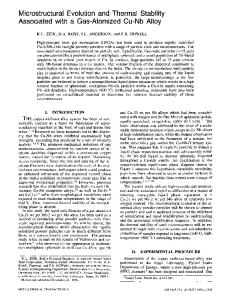Cesium State, Thermal Evolution in CsC 24
- PDF / 370,946 Bytes
- 6 Pages / 420.48 x 639 pts Page_size
- 85 Downloads / 802 Views
CESIUM STATE, THERMAL EVOLUTION IN CsC 24 H. ESTRADE-SZWARCKOPF,
J. CONARD, P. LAUGINIE, CRSOCI-CNRS,45045 ORLEANS CEDEX J. VAN DER KLINK, Institut de Physique Expdrimentale, EPFL, CH-1015 LAUSANNE P. LAGRANGE,
D. GUERARD, F. ROUSSEAUXL.C.M.A. NANCY BP.239, 54506 VANDOEUVRE
A. MAAROUFI, C.R.P.P. Universitf de BORDEAUX I, 33405 TALENCE G. HERMANN,
Bruker Spectrospin, 67160 WISSEMBOURG
ABSTRACT By 133Cs and 13C NMR, EPR, susceptibility anisotropy and X-Ray diffraction,we studied the thermal evolution of Cs2 4 from 100 to 500 K. A smooth transition is observed near 300 K which can be interpreted in structural and electronic terms at lower temperatures, the Cs atoms are located in a disordered manner on graphitic hexagonal sites and are almost completely ionized; in the high temperature state, the Cs atoms are completely disordered relatively to the graphitic lattice and their electrons are at least partly relocalized on the metallic s-function. INTRODUCTION Papers devoted to the Cs planar structure in Cs-graphitides [1,2] generally concluded that at 300 K, Cs atoms are not registered upon the graphite lattice and build a true disordered liquid phase intstage II. In this second stage CsGIC, we are going to show that this conclusion should be somewhat reconsidered. Indeed, intercalated metal NMR technique allows the determination of short range order effects and further light can be acquired concerning the amount of remaining 3 s-character on inserted Cs atoms and the symmetry of their sites. f 3 Cs NMR results are reported here and compared with those coming from other experimental methods such as X-Ray diffraction, magnetic susceptibility anisotropy, EPR and 13 C NMR, to get more informations about the transition observed between 200 and 500 K [3]. 13 3 Cs NUCLEAR MAGNETIC RESONANCE We recall,briefly, results given at Trieste Conference, obtained at 11.8 MHz [31 together with new ones obtained at higher Larmor frequency (44 MHz). They fairly agree with older ones [4]. All those measurements were performed on powders in sealed tubes; the dead volume above the sample is very small such that, the whole tube remains at the same temperature and stoichiometric stability is insured. Line position and line shape As seen in Fig.1, in contrast to stages I, III and IV, the second stage line shifts rapidly towards low fields above 200 K, crossing the reference position near 300 K to reach 1000 ppm at 480 K. A quadrupolar second order splitting is observed at 11.8 MHz from 100 to 500K in stages III and IV, from 100 to 300 K in stage II. The lineshape is, in these cases characteristic of an axial symmetry for the Cs sites (Fig. 2). * Present address : Lab. de Cristallographie,Universiti d'Orldans,45045 ORLEANS
Mat. Res. Soc. Symp. Proc. Vol. 20 (1983) QElsevier Science Publishing Co.,
Inc.
370
Fig. 2.
133Cs NMR in CsC2 4 powder lineshape and position. In both sets of spectra, at low temperatures, the distinct shapes are charac- teristic of axial symmetry for the Cs sites - at 11.8 MHz dominant guadrupolar second order sp
Data Loading...











